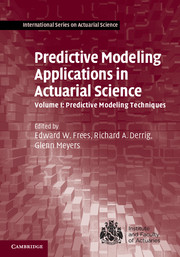Book contents
- Frontmatter
- Contents
- Contributor List
- Acknowledgments
- 1 Predictive Modeling in Actuarial Science
- II Predictive Modeling Foundations
- 2 Overview of Linear Models
- 3 Regression with Categorical Dependent Variables
- 4 Regression with Count-Dependent Variables
- 5 Generalized Linear Models
- 6 Frequency and Severity Models
- II Predictive Modeling Methods
- III Bayesian and Mixed Modeling
- IV Longitudinal Modeling
- Index
- References
4 - Regression with Count-Dependent Variables
from II - Predictive Modeling Foundations
Published online by Cambridge University Press: 05 August 2014
- Frontmatter
- Contents
- Contributor List
- Acknowledgments
- 1 Predictive Modeling in Actuarial Science
- II Predictive Modeling Foundations
- 2 Overview of Linear Models
- 3 Regression with Categorical Dependent Variables
- 4 Regression with Count-Dependent Variables
- 5 Generalized Linear Models
- 6 Frequency and Severity Models
- II Predictive Modeling Methods
- III Bayesian and Mixed Modeling
- IV Longitudinal Modeling
- Index
- References
Summary
Chapter Preview. This chapter presents regression models where the random variable is a count and compares different risk classification models for the annual number of claims reported to the insurer. Count regression analysis allows identification of risk factors and prediction of the expected frequency given characteristics of the risk. This chapter details some of the most popular models for the annual number of claims reported to the insurer, the way the actuary should use these models for inference, and how the models should be compared.
Introduction
In the early 20th century, before the theoretical advances in statistical sciences, a method called the minimum bias technique was used to find the premiums that should be offered to insureds with different risk characteristics. This technique's aim was to find the parameters of the premiums that minimize their bias by using iterative algorithms.
Instead of relying on these techniques that lack theoretical support, the actuarial community now bases its methods on probability and statistical theories. Using specific probability distributions for the count and the costs of claims, the premium is typically calculated by obtaining the conditional expectation of the number of claims given the risk characteristics and combining it with the expected claim amount. In this chapter, we focus on the number of claims.
- Type
- Chapter
- Information
- Predictive Modeling Applications in Actuarial Science , pp. 87 - 106Publisher: Cambridge University PressPrint publication year: 2014
References
- 2
- Cited by

